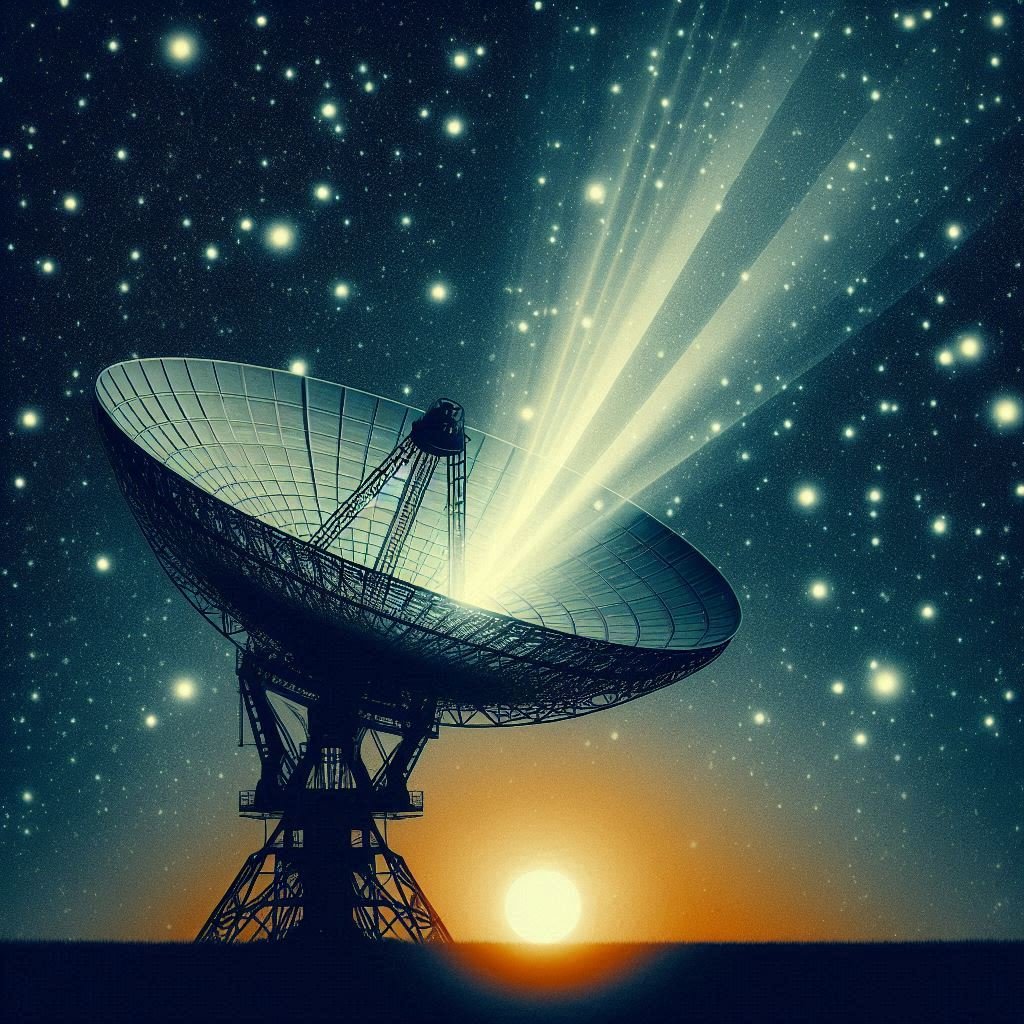Imagine sitting in a dark, quiet room, surrounded by giant computers humming softly, when suddenly, one of them picks up something no human has ever heard before—a sound from deep space.
A sound that lasts exactly 72 seconds.
It’s not a meteor. It’s not a satellite.
It’s not static.
It’s… something else.
This is the story of the Wow! Signal, one of the strangest and most exciting mysteries in the history of science—a signal so powerful, so precise, and so unexplained, that even today, almost fifty years later, people still wonder:
Was this our first message from aliens?
A Quiet Night in Ohio
It’s the evening of August 15, 1977, at Ohio State University’s “Big Ear” radio telescope—a massive, white, rectangular structure standing quietly in the fields outside Delaware, Ohio.
Inside, astronomer Dr. Jerry Ehman is working the night shift, scanning the heavens for radio signals.
Back then, there was no internet, no high-speed computers, and certainly no fancy software that analyzed signals in real time. Instead, the telescope’s data printed out on long sheets of paper—rows of numbers and letters representing the strength of radio waves coming from space.
For hours, everything is normal. Just static. Background noise. The usual hum of the universe.
And then, out of nowhere… something extraordinary happens.
The Signal
When Dr. Ehman reviews the printout the next day, he stops cold.
There, in the middle of a long, boring stream of data, is a sudden, massive spike—six lines of numbers and letters that leap off the page like a scream in the silence.
6EQUJ5.
Those six characters represent a signal that lasted exactly 72 seconds—the longest and strongest signal the Big Ear had ever detected.
Ehman stares at it, stunned.
He knows what random noise looks like. This isn’t it. This is organized. Sharp. Deliberate.
The signal came from a fixed point in the sky, near the constellation Sagittarius, close to a star system known as Chi Sagittarii.
It didn’t repeat. It didn’t fade. It just appeared, burned bright, and disappeared.
Ehman is so amazed that he grabs a red pen, circles the strange reading, and scribbles one word in the margin:
“Wow!”
That single word would become the signal’s name—the Wow! Signal—and it would haunt scientists for decades.
What Made It So Special
Radio waves are everywhere. Stars emit them. Planets reflect them. Even your microwave leaks a bit of radiation. But this signal? It was different.
The Wow! Signal came in at a very specific frequency—1420 megahertz.
That’s important, because 1420 MHz is the exact frequency of hydrogen, the most common element in the universe. Scientists had long speculated that if aliens ever wanted to broadcast a message across space, they’d probably use that frequency—it’s like the universal “language” of the cosmos.
And that’s exactly where this signal appeared.
It wasn’t random static. It was strong. Focused. Intentional.
So, naturally, everyone at Ohio State freaked out.
They checked for satellites, aircraft, weather balloons, radio interference—nothing matched. No known object could have created a signal like that.
It came from deep space.
And then… it was gone.
The Search for the Source
For weeks, the Big Ear telescope pointed back toward Sagittarius, waiting for the signal to return. It never did.
Other observatories tried to detect it. They got nothing.
It was as if someone—or something—had spoken once… and then vanished forever.
Dr. Ehman and his colleagues began ruling out possibilities one by one.
Could it have been a secret military transmission? Unlikely—the frequency was protected and not used by humans.
Could it have been a comet? Not really—comets don’t emit that kind of narrowband radio signal.
Could it have been a reflection from Earth, bouncing off space debris? Maybe—but the angle didn’t fit.
No matter how they analyzed it, the conclusion was the same: this was not a normal natural phenomenon.
It was the kind of thing you’d expect from an intelligent source.
And yet, there was no way to prove it.
The Silence After
For years, astronomers around the world kept listening. New telescopes scanned the same area of the sky, hoping to catch another “Wow!” But they never did.
Not once.
And that’s what makes the mystery so eerie.
In science, repetition is everything. You can’t build a theory on something that happened just once. So the Wow! Signal sat in this strange limbo—too real to ignore, too brief to explain.
Dr. Ehman himself, the man who discovered it, spent the rest of his life searching for answers. He later said, “It was probably a natural event.” But even he admitted—no one ever found what kind.
It was as if the universe had whispered one word… and then gone silent forever.
The Human Imagination
Of course, once the public found out, the theories exploded.
Some believed it was definitely a message from an alien civilization—a mathematical “ping” saying, We’re here.
Others thought it might have been a probe or a spacecraft passing by.
A few even wondered if it was a warning.
Movies, books, and documentaries turned it into legend. People imagined strange worlds orbiting Chi Sagittarii—civilizations that saw our planet, sent out a beacon, and then kept moving through the stars.
It was the kind of mystery that blurs the line between science and storytelling—something so perfectly weird, it could make anyone believe.
The Logical Explanations
Scientists, of course, kept looking for a rational answer.
Decades later, new theories emerged.
In 2017, an astronomer named Antonio Paris suggested the signal might have been caused by a comet—specifically, one passing through that area in 1977. Comets can emit hydrogen gas, which could theoretically produce a signal near the same frequency.
But other scientists quickly pushed back.
If that were true, they argued, we’d see similar signals from other comets—and we don’t. The Wow! Signal didn’t behave like anything we’ve ever seen from comets or planets.
Even today, no single theory fits all the facts.
It’s like a puzzle with one piece missing.
The Meaning Behind the Mystery
Whether it was a comet, a glitch, or something truly extraterrestrial, the Wow! Signal changed the way we look at the universe.
For the first time, people realized that if life exists out there, it might not come knocking on our front door—it might reach us in a single burst of radio energy, gone before we even know what it means.
It also reminded us how fragile our ability to listen really is.
In 1977, the Big Ear telescope was one of the only instruments in the world scanning for alien signals. It has since been torn down—replaced by a golf course, of all things.
So, if that signal came again today, would we even hear it?
Maybe. Maybe not.
What If It Was a Message?
Let’s imagine for a second that it really was.
If the Wow! Signal was sent by an intelligent civilization, it would have come from light-years away. That means whoever sent it might have been gone for centuries by the time we heard it.
Or maybe… they’re still listening.
Maybe the signal wasn’t a message, but a response.
What if someone out there picked up one of our early broadcasts—our first radio or TV signals leaking into space—and decided to answer back?
A 72-second burst, aimed precisely at us, as if to say:
We heard you.
And then silence, because the distance between us is so great that it’ll take another century for the next word to arrive.
The Echo That Never Ends
Every time we point our telescopes at the stars, we’re doing more than searching for planets or galaxies—we’re listening for echoes.
The Wow! Signal is one of those echoes that refuses to fade.
It’s a reminder that the universe is vast, mysterious, and maybe—just maybe—not entirely empty.
In 72 seconds, it gave us hope, fear, curiosity, and wonder. It made scientists rethink everything they thought they knew about the sky.
And it gave humanity a story we still can’t stop telling:
That once, on a quiet night in Ohio, the universe spoke.
And we’re still trying to figure out what it said.




